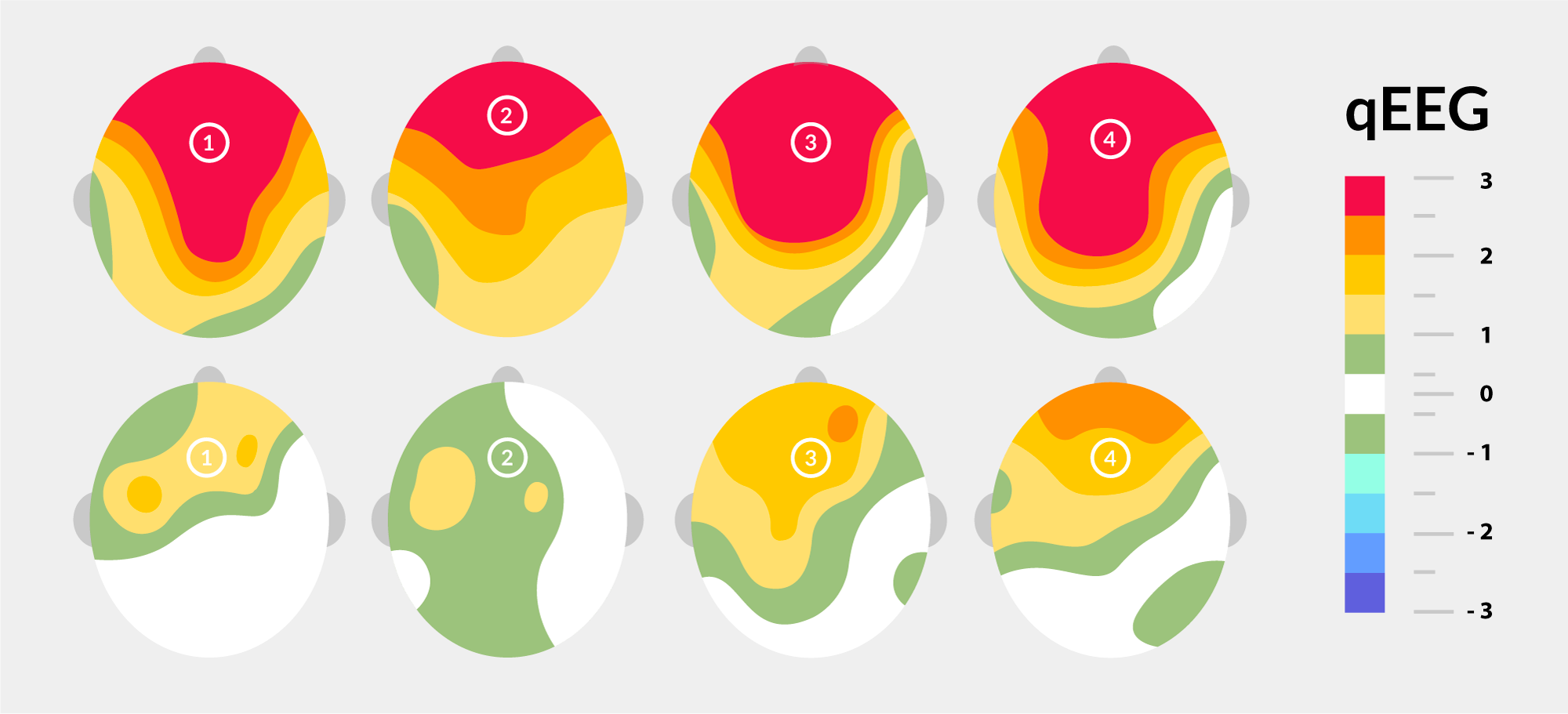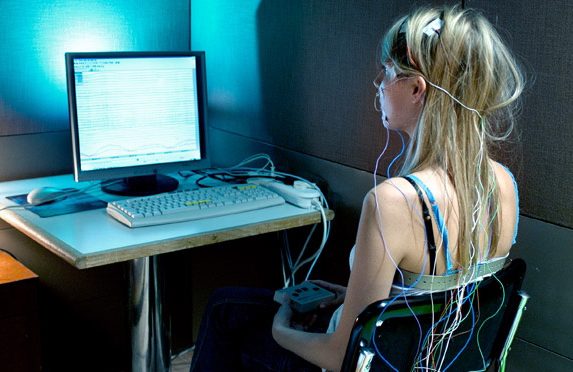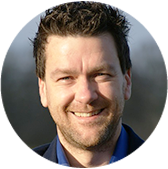qEEG Brain Mapping
Conveniently located to serve the areas of Santa Monica, Venice, South Bay, Brentwood, Beverly Hills, Pasadena and all of Greater Los Angeles

Contents
- 1 qEEG Brain Mapping
- 1.1 About qEEG Brain Mapping
- 1.2 qEEG Brain Mapping Procedure
- 1.3 qEEG Brain Mapping Results
- 1.4 What is Neurofeedback Training?
- 1.5 Benefits of Neurofeedback Training
- 1.6 Who is a Candidate for Neurofeedback Training?
- 1.7 Neurofeedback Protocol
- 1.8 Recovery from Neurofeedback Training
- 1.9 Neurofeedback Training Results
- 1.10 How Much Does Neurofeedback Training Cost in Los Angeles?
- 1.11 FAQ
- 1.12 References
qEEG Brain Mapping
QEEG Brain Mapping is a computer-powered measurement and analysis of the brain’s activity. It measures different sizes and frequencies of brainwaves, all of which correlate to particular kinds of brain activity. Using the information gathered by qEEG brain mapping, the specialists at NeuroZone can diagnose various conditions, as well as create treatment plants for cognitive therapies like neurofeedback training. We offer expert qEEG brain mapping to serve the areas of Santa Monica, Venice, South Bay, Brentwood, Beverly Hills, Pasadena, and Greater Los Angeles. For more information, call (310) 821-3640 (Playa Del Rey & Santa Monica), (424) 247-8193 (Redondo Beach) or contact us online.
About qEEG Brain Mapping
Conventional Electroencephalography (EEG) is a measurement of the brain’s electrical activity using sensors placed on the scalp. Electrical patterns in the brain are commonly known as brainwaves. These waveforms include a mixture of frequencies, amplitudes, locus of phenomena, and regulation of voltage and frequencies which all represent brain activity.
Quantitative EEG (qEEG), or brain mapping, is a computer analysis of the EEG signal using 19 or more channels of simultaneous EEG recording. Raw EEG data is first recorded, then analyzed and compared against a reference database of “normal” subjects. This type of evaluation is used as an extension of the EEG interpretation, to provide further analyses of brain function for clinical purposes to treat a variety of conditions. The rhythmic cycles observed in the EEG recording represent the brain activity between the cortex and the thalamus.
The 19 channels are represented by 19 electrodes located inside a cap which we place on the patient’s head, against the scalp, to evaluate brainwave function. This placement is called the 10-20 International System of Electrode Placement. The cap, with its 19 channels, produces an analysis of the brainwaves in terms of numbers that represent elements of the brainwave such as frequency, voltage/amplitude or power, location of phenomena, waveform shape, waveform occurrence, regulation of voltage and frequency, and reactivity. When these elements are combined with other evaluation measures we can, with relative accuracy, determine the type and location of the neurofeedback.
qEEG Brain Mapping Procedure
The qEEG Brain Mapping procedure typically takes thirty to forty-five minutes to complete. It involves placing a cap containing small electrodes on the head. These electrodes measure the electrical activity coming from the brain. This procedure takes place while the client is sitting in a chair with their eyes open and then closed, or while the client is performing a task like reading. The client must remain calm and in a resting state throughout the assessment process, to produce accurate results.
qEEG Brain Mapping Results
The results of the qEEG analysis are represented in the form of statistical tables and topographic maps. These topographic maps provide a convenient schematic representation of the relationships among the EEG waveforms, map displays, and the results of the statistical analyses. We statistically compare the data that we collect from the qEEG to a large normative database which provides information about how brain waves should look and operate at different ages. With this analysis, we can determine if the client’s brainwave patterns are different from normal, and if so, how they are different and where these differences occur.
The qEEG can aid in the diagnosis of many conditions because it can help describe specific areas of strength and weaknesses in brain function. It can help reveal the underlying neurophysiology associated with a variety of disorders. (1) These include:
- Attention Deficit Disorder/Attention Deficit Hyperactivity Disorder (ADD/ADHD)
- Traumatic Brain Injury (TBI)
- Learning Disabilities
- Language Disorders
- Sensory Processing Disorders
- Auditory Processing Disorders
- Anxiety/Depression
- Post-Traumatic Stress Disorder (PTSD)
- Obsessive-Compulsive Disorder (OCD)
- Insomnia
- Emotional Regulation Difficulties
- Reading Disorders
Three qEEG spectral variable categories are of clinical value for treatment purposes such as neurofeedback training. These variables are all presented in the qEEG/brain map analysis as part of the overall assessment of brain function. Neurofeedback training will involve at least one and often a combination of approaches to address these variables. These variables are:
- Power/amplitude
- Coherence and/or phase
- Derived ratios of amplitude and/or coherence and/or phase
The results of qEEG brain mapping can be used to create a goal-oriented treatment plan for neurofeedback training.
What is Neurofeedback Training?
Neurofeedback training utilizes brainwave biofeedback technology. With this cutting-edge technology, the brain’s electrical activity is related to a computer through electrodes placed at various locations on the scalp. The neurofeedback equipment records, in real-time, information about brainwave function and relays that information into a feedback system that provides instantaneous audio and visual feedback to the patient. This allows the patient to automatically influence their brainwaves through a series of exercises, experiencing the retraining of their brain in real-time. Over time, the immediacy of feedback in the learning process can change the brain’s natural operating pattern.
About Brainwaves
Brainwaves are a measurable representation of brain activity. For neurofeedback training, they can be measured using three metrics: frequency (measured in Hz), amplitude, and wavelength. Using the varying scopes of these measurements, brainwaves can be categorized into five different frequency bands: Delta, Theta, Alpha, Beta, and Gamma.
- Delta waves – associated with deep restorative sleep. They are sometimes present when certain areas of the brain are not active, causing learning disabilities.
- Theta waves – associated with deep relaxation. They can also represent mental incompetence.
- Alpha waves – associated with attentive relaxation, in which one can switch gears between different activities and complete tasks easily.
- Beta waves – associated with alert and anxious wakefulness. They are present when one is taking in information and thinking to solve problems, form judgments, and make decisions.
- Gamma waves – associated with intense and pointed attention, as well as dealing with information from multiple parts of the brain.
As listed, these waves move from high amplitude and low frequency to low amplitude and high frequency as they move from deep sleep to states of hyper-focused attention. The scientific understanding of these waves and how they relate to brain functionality allow neurofeedback training to accurately target and retrain the brain.
Benefits of Neurofeedback Training
This procedure can help treat patients with a wide variety of conditions. These include:
- Attention deficit disorders
- Learning disorders
- Behavioral disorders
- Autism
- Aspergers
- Pervasive developmental disorders
- Sensory processing disorders
- Language disorders
- Cognitive problems
- Reading/writing challenges
- Anxiety
- Depression
- Executive Dysfunction
- Addiction
- Concussion / Head Injury
- Sleep disturbances
- Personality disorders
- Bipolar disorders
- Stroke
- Dysgraphia
- Academic challenges
- Headaches and migraines
- Peak performance
- Cognitive enhancement
In most cases, if a particular brain pattern has a negative effect on the life of a patient, neurofeedback training can help to change that pattern in a more comfortable and productive direction. This treatment can help with brain regulation, behaving appropriately in relation to stimuli, the consistency of the brain’s connectivity, and general functionality.
Who is a Candidate for Neurofeedback Training?
Patients from age two and up can benefit from neurofeedback training. However, younger patients must be able to sit still and remain focused on particular stimuli. They must also be able to tolerate wearing the neurofeedback equipment on their head, including the small leads that rest directly on the scalp in order to measure brainwaves.
To learn more about qEEG brain mapping, neurofeedback training, and your eligibility, call (310) 821-3640 (Playa Del Rey & Santa Monica), (424) 247-8193 (Redondo Beach) or fill out this form.
Neurofeedback Protocol
We use the results of qEEG Brain Mapping to create a personalized treatment plan, or “neurofeedback protocol,” for each patient. These protocols detail the game plan for the treatment, as well as how long it should take.
Each patient’s neurofeedback protocol deals with certain aspects of neurofeedback training. These include:
- Lead sites- the particular locations on the scalp where the leads will be attached
- The brainwave frequency bands that will be inhibited or reinforced
- The threshold of brainwave conditions that prompt reinforcement or inhibition
- The form of audio or visual feedback that will be used in training
- How long the feedback will be introduced
The amount of sessions that each patient requires is totally unique to them. It can depend on the severity of the condition, the age of the patient, and their ability to go along with the protocol. On average, neurofeedback training takes twenty to fifty sessions to complete.
Recovery from Neurofeedback Training
Neurofeedback training is a noninvasive treatment, so there is little recovery, healing, or downtime to speak of. Compared to the prescription medications that are commonly used to treat similar symptoms, there are no potentially toxic side effects. This is because neurofeedback training is an endogenous neuromodulator, which means the chemical changes that are being made to the brain are originating from within the brain. (2) After your treatment sessions, you may feel some tiredness, spaciness, or anxiousness. These side effects are typically mild and temporary. If your symptoms persist, we can alter your treatment course to accommodate.
Neurofeedback Training Results
The results of neurofeedback training can begin to show themselves early on in the treatment process. However, many of the conditions that we treat are very complicated, so it can be difficult to measure. Neurofeedback protocols typically have two or three phases of training, and we perform qEEG brain mapping after each one to assess how the brain might have changed. Each brain map assessment can be used to develop new goals and to change the neurofeedback protocol as your treatment progresses. We will adapt your treatment as your brain changes, making sure that you have a healthier brain as a final result of your treatment.
How Much Does Neurofeedback Training Cost in Los Angeles?
The price of neurofeedback training can vary widely depending on the number of sessions you need, among other factors. Occasionally, insurance companies agree to pay for their client’s neurofeedback training. To find out more about how much neurofeedback training costs at Neurozone, call (310) 821-3640 (Playa Del Rey & Santa Monica), (424) 247-8193 (Redondo Beach) or visit our contact page.
FAQ
How long does a qEEg brain mapping session last?
qEEG brain mapping takes about one hour to complete.
Can I receive a qEEG brain map on medication?
Most medications are compatible with qEEG brain mapping and will not interfere with results. However, if you are prescribed stimulant medication, you should wait until after the session to take it.
Is neurofeedback training permanent?
Because neurofeedback training trains the brain’s natural behavioral patterns, the results should be long-lasting. However, the brain is susceptible to environmental change, behavioral change and trauma, so you may need additional training down the line to maintain your results.
References
- Livint Popa L, Dragos H, Pantelemon C, Verisezan Rosu O, Strilciuc S. The Role of Quantitative EEG in the Diagnosis of Neuropsychiatric Disorders. Journal of Medicine and Life. 2020;13(1):8-15. doi:https://doi.org/10.25122/jml-2019-0085
- Babaskina L, Afanasyeva N, Semyonkina1 M, Myasnyankina O, Sushko N. Effectiveness of Neurofeedback Training for Patients with Personality Disorders: A Systematic Review. Iranian Journal of Psychiatry. 2023;18(3):352-361. doi:https://doi.org/10.18502/ijps.v18i3.13014






